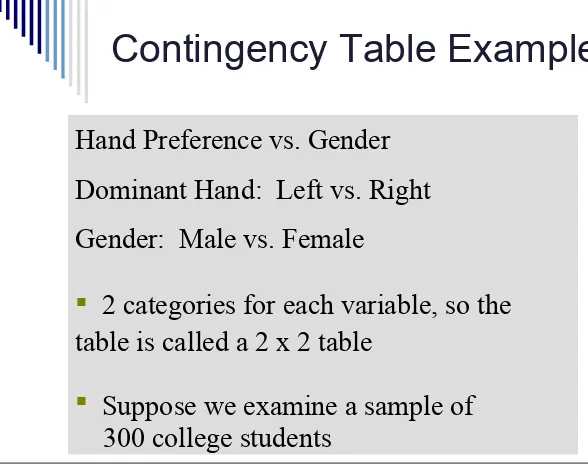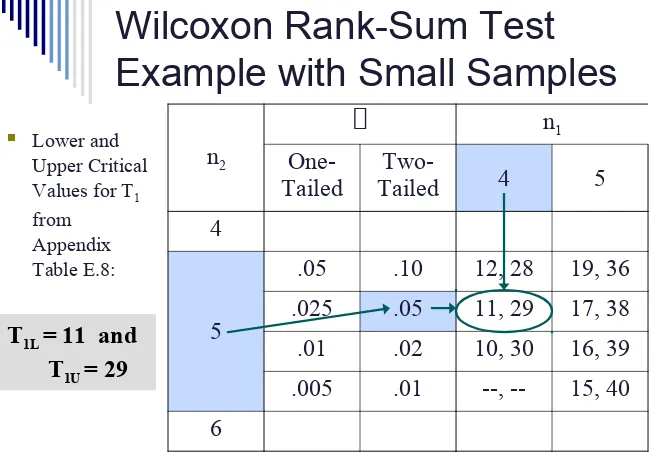Statistics for Managers
Using Microsoft® Excel
5th Edition
Chapter 12
Learning Objectives
In this chapter, you learn:
How and when to use the chi-square test for
contingency tables
How to use the Marascuilo procedure for
determining pair-wise differences when
evaluating more than two proportions
Contingency Tables
Contingency Tables
Useful in situations involving multiple
population proportions
Used to classify sample observations
according to two or more characteristics
Contingency Table Example
Hand Preference vs. Gender
Dominant Hand: Left vs. Right
Gender: Male vs. Female
2 categories for each variable, so the
table is called a 2 x 2 table
Suppose we examine a sample of
Contingency Table Example
Sample results organized in a contingency table:
Hand
Preference
Gender
Female
Male
Left
12
24
36
Right
108
156
264
120
180
300
120 Females, 12 were
left handed
180 Males, 24 were
left handed
Contingency Table Example
If H
0
is true, then the proportion of left-handed females
should be the same as the proportion of left-handed males.
The two proportions above should be the same as the
proportion of left-handed people overall.
H
0
: π
1
= π
2
(Proportion of females who are left
handed is equal to the proportion of
males who are left handed)
H
1
: π
1
≠ π
2
(The two proportions are not the same –
The Chi-Square Test Statistic
where:
f
o
= observed frequency in a particular cell
f
e
= expected frequency in a particular cell if H
0
is true
2
for the 2 x 2 case has 1 degree of freedom
cells
all
e
2
e
o
2
f
)
f
(f
χ
The Chi-square test statistic is:
The Chi-Square Test Statistic
Decision Rule:
If
2
>
2
U
, reject H
0
,
otherwise, do not reject
H
0
The
2
test statistic approximately follows a chi-square
distribution with one degree of freedom
2
U
0
Reject H
0Do not
Computing the
Average Proportion
Here:
120 Females, 12 were
left handed
180 Males, 24 were
left handed
The proportion of left handers overall is 0.12, that is, 12%
n
The average
Finding Expected Frequencies
To obtain the expected frequency for left handed females,
multiply the average proportion left handed (p) by the total
number of females
To obtain the expected frequency for left handed males,
multiply the average proportion left handed (p) by the total
number of males
If the two proportions are equal, then
P(Left Handed | Female) = P(Left Handed | Male) = .12
i.e., we would expect
(.12)(120) = 14.4 females to be left handed
Observed vs. Expected
Frequencies
Hand
Preference
Gender
Female
Male
Left
Observed = 12
Expected = 14.4
Observed = 24
Expected = 21.6
36
Right
Observed = 108
Expected = 105.6
Observed = 156
Expected = 158.4
264
The Chi-Square Test Statistic
Hand
Preference
Gender
Female
Male
Left
Observed = 12
Expected = 14.4
Observed = 24
Expected = 21.6
36
Right
Observed = 108
Expected = 105.6
Observed = 156
Expected = 158.4
264
120
180
300
7576
The Chi-Square Test Statistic
Decision Rule:
If
2
> 3.841, reject H
conclude that there is
2
Test for The Differences Among
More Than Two Proportions
Extend the
2
test to the case with more than two
independent populations:
H
0
: π
1
= π
2
= … = π
c
The Chi-Square Test Statistic
where:
f
o
= observed frequency in a particular cell of the 2 x c table
f
e
= expected frequency in a particular cell if H
0
is true
2
for the 2 x c case has (2-1)(c-1) = c - 1 degrees of freedom
Assumed: each cell in the contingency table has expected frequency of at
least 1
cells
all
2
2
(
)
e
e
o
f
f
f
Computing the
Overall Proportion
n
The overall
proportion is:
Expected cell frequencies for the c categories are
calculated as in the 2 x 2 case, and the decision rule
is the same:
Decision Rule:
If
2
>
2
U
, reject H
0
,
otherwise, do not
reject H
0
Where
2
U
is from the
2
Test with More Than Two
Proportions: Example
The sharing of patient records is a
controversial issue in health care. A survey
of 500 respondents asked whether they
objected to their records being shared by
insurance companies, by pharmacies, and by
medical researchers. The results are
2
Test with More Than Two
Proportions: Example
Object to
Record
Sharing
Organization
Insurance
Companies
Pharmacies
Medical
Researchers
Yes
410
295
335
2
Test with More Than Two
Proportions: Example
6933
The overall
proportion is:
Object to
Record
Sharing
Organization
Insurance
Companies
Pharmacies
Medical
Researchers
2
Test with More Than Two
Proportions: Example
Object
to
Record
Sharing
Organization
Insurance
Companies
Pharmacies
Medical
Researchers
Yes
2
Test with More Than Two
Proportions: Example
Decision Rule:
If
2
>
2
U
, reject H
0
,
otherwise, do not reject H
0
2
U
= 5.991 is from the
chi-square distribution with 2
degrees of freedom.
H
0
: π
1
= π
2
= π
3
H
1
: Not all of the π
j
are equal (j = 1, 2, 3)
Conclusion: Since 64.1196 > 5.991, you reject H
0
and you
conclude that
at least one proportion of respondents who object to
their records being shared is different across the three
The Marascuilo Procedure
The
Marascuilo procedure
enables you to
make comparisons between all pairs of
groups.
First, compute the observed differences p
j
- p
j’
among all c(c-1)/2 pairs.
The Marascuilo Procedure
Critical Range for the Marascuilo Procedure:
/

